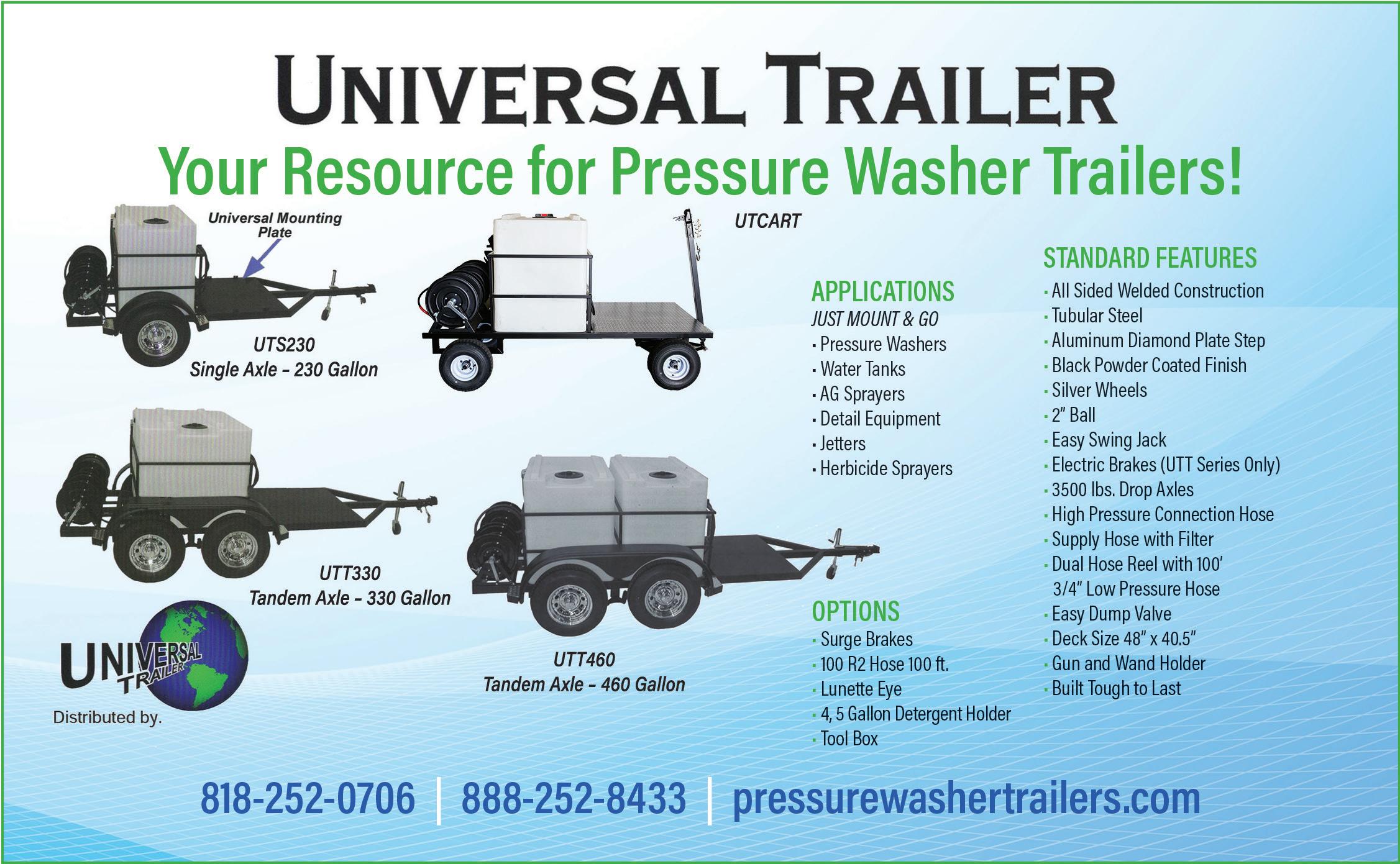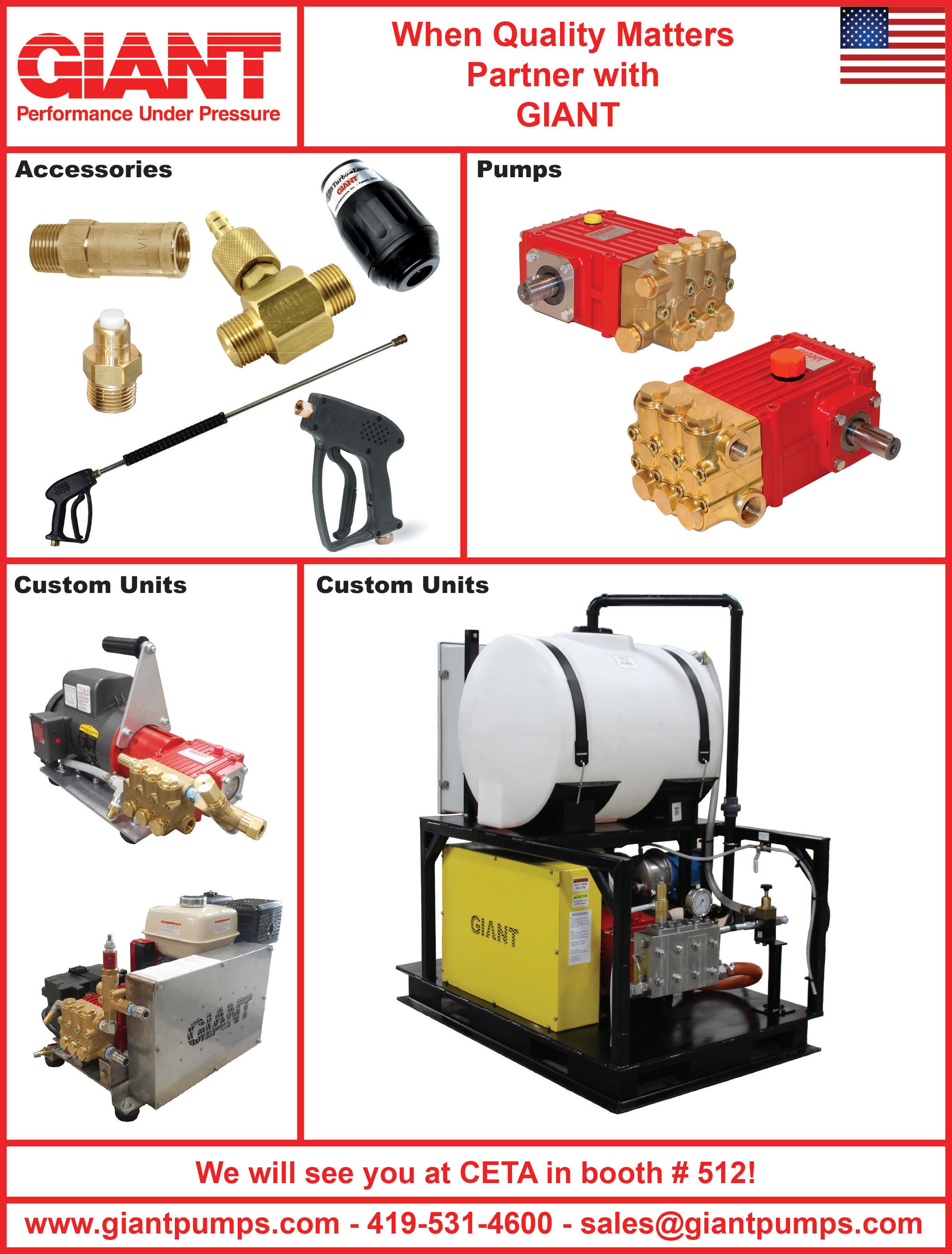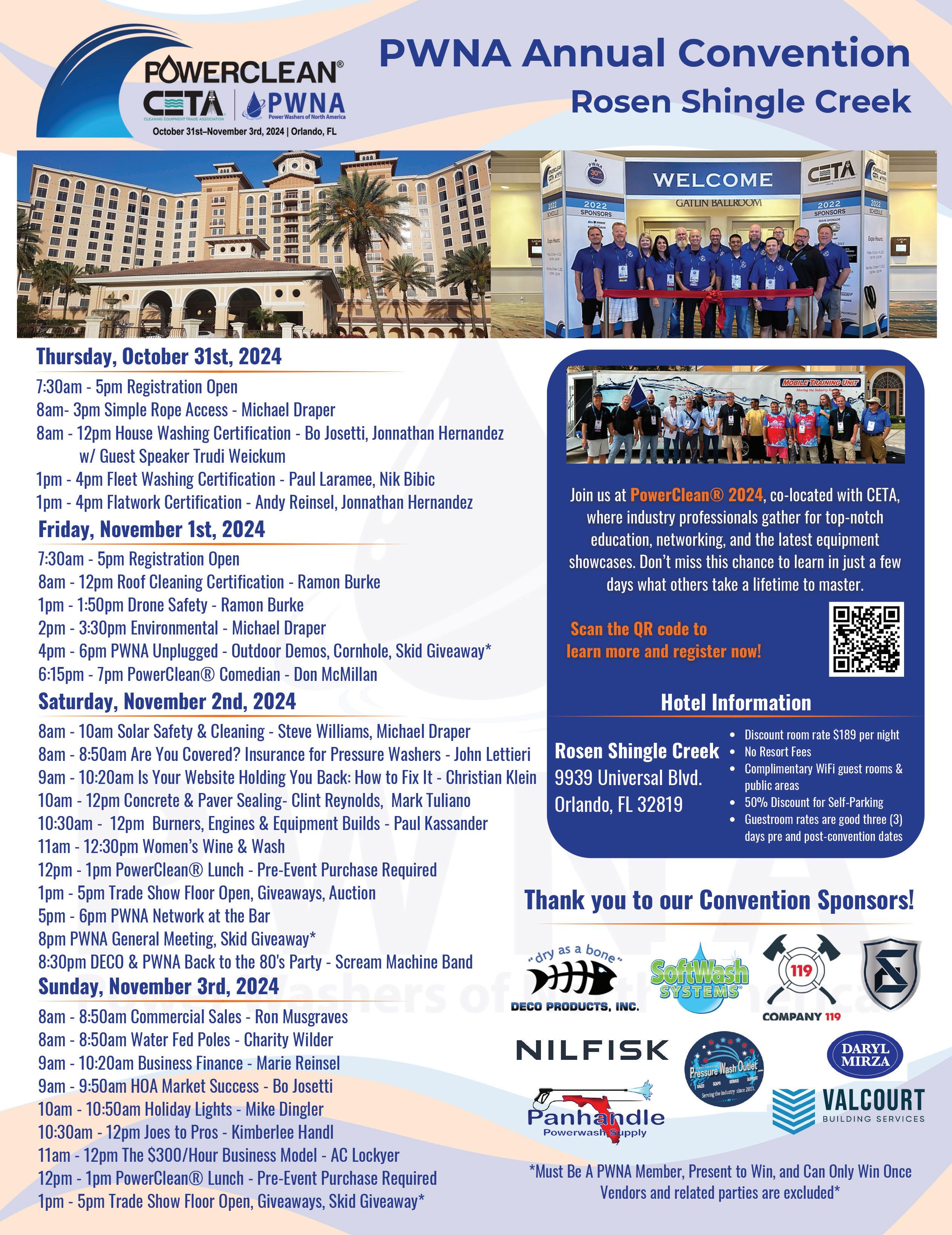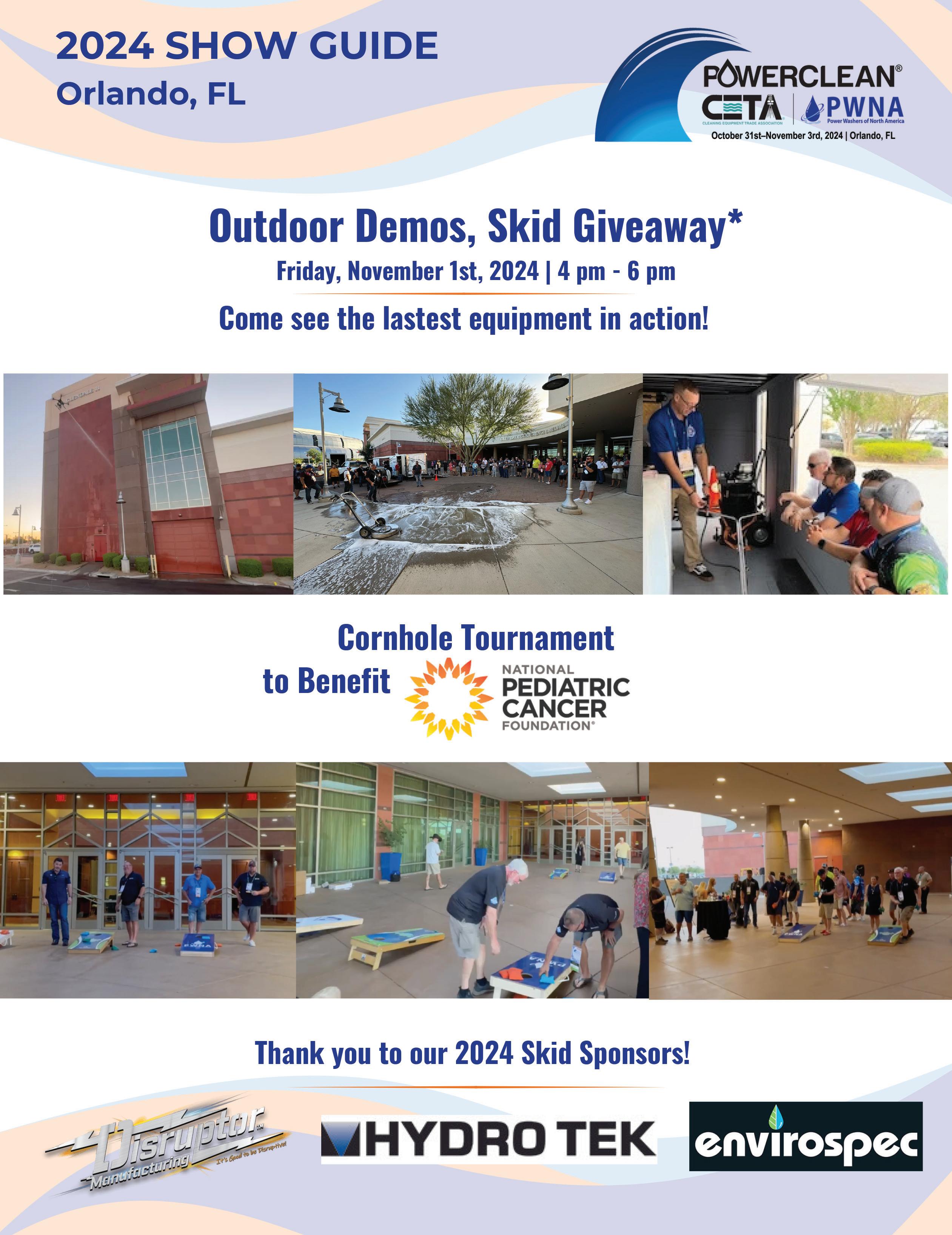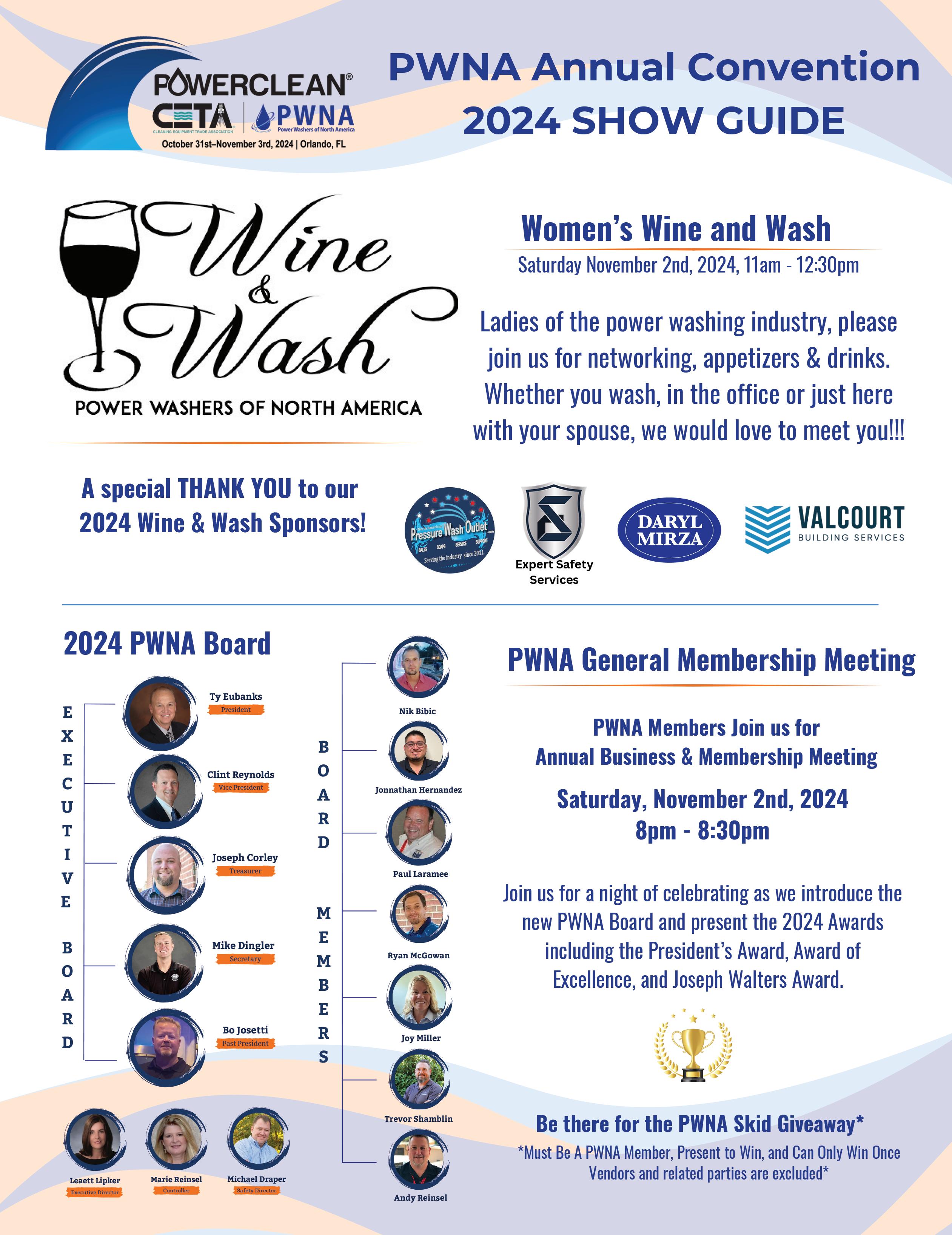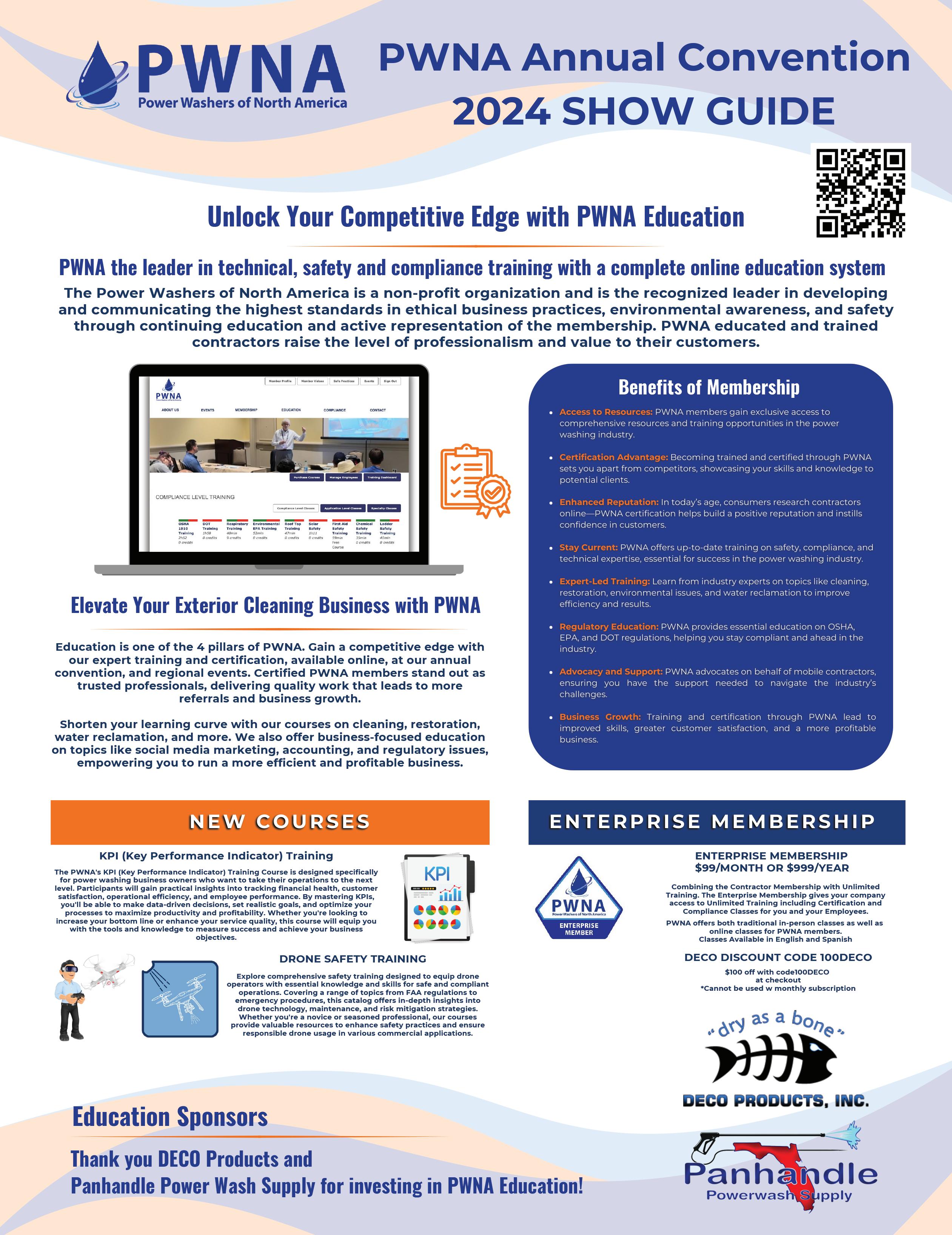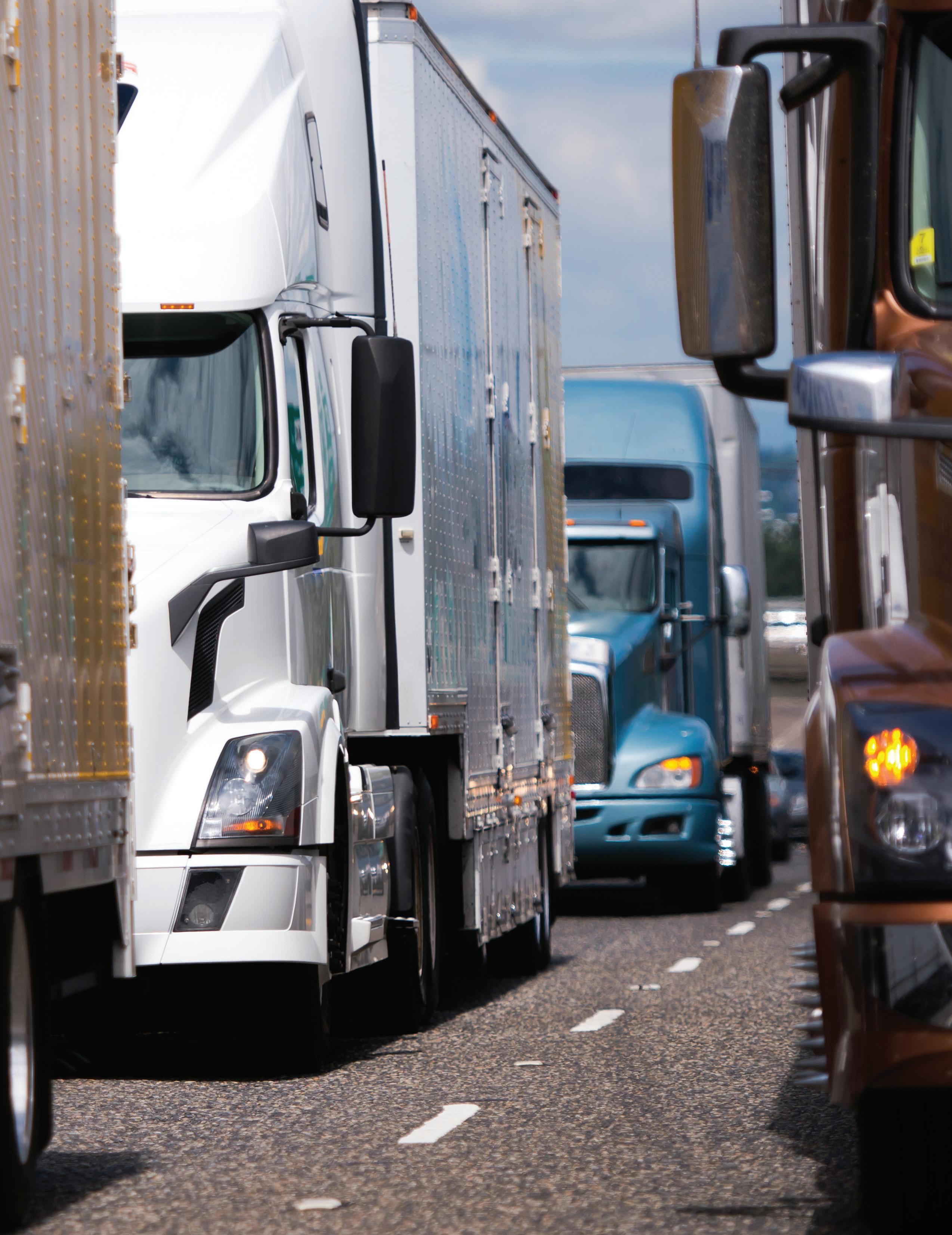
20 minute read
FLEET WASHING TOOLS
by Diane M. Calabrese
Sixty-eight percent is a sizeable share of anything. It happens to be the share of goods transported around the United States by trucks.
Some 13 million trucks—approximately 2.9 million of them semis (18-wheelers)—get the job done. (To sample dazzling data on just how much trucks mean to the U.S. economy, see the May 17, 2024, column by Scott Elgin at TruckInfo.net.)
The economy depends on trucks. No, trucks have not supplanted boats. But the word “fleet” derives from the Old English for “float.” Thus, fleets of trucks are aligned in more ways than one with boats.
Trucks incorporate components that get the attention of the Environmental Protection Agency (EPA), components such as brake fluid, battery acid, motor oils, fuels, and lubricants. The EPA keeps a watchful eye on trucks.
Washing a truck involves not only getting it clean, but also reducing (or eliminating) any impact on the environment from the wastewater and residues removed from the truck.
The National Pollutant Discharge Elimination System (NPDES), which is under the purview of the EPA, requires states to set goals that limit and keep reducing pollutants. The reporting schemes of the states are aggregates of data states require from their subregions.
Permitting is the mechanism that keeps the NPDES gears moving. In many places a fleet washer will require its own permit or must demonstrate that its washing operation falls under the umbrella of another permit holder.
As regulations become more stringent, the wash water used for cleaning fleets correspondingly becomes more likely to need an oil/water separator, biosystem, evaporators, and so on. In other words, scrutiny as well as industry concerns are spurring innovation in fleet washing tools and methods.
Selecting chemicals with care on the front side can, of course, ease cleanup on the back side. For instance, chemicals with quick-release surfactants help at wash-water pools because the oils and grease residues come to the surface (for treatment) much faster. Ideally, cleaning wastewater so that it can be recycled and reused maximally on site is the future. Any fleet-washing tool that carries us toward the goal will be incorporated as an important part of the washing process.
“Less is more” applies. Tools for fleet cleaning that minimize the amount of water used also move the industry forward to an environmentally sustainable place.
Waste has a way of accumulating—something we each realize whenever we take out the trash for its regular pickup and haul away. A 2009 EPA study in Federal Way, WA, resulted in some astounding numbers for waste from vehicle washing. The tally for a year included 190 gallons of gasoline, diesel, and motor oil; 14 pounds of dissolved copper; and 60 pounds of ammonia.
That’s the short list. But we get the idea of how compounds we would not want to send to surface waters accumulate.
Our industry is firmly committed to best practices to meet all provisions stemming from the Clean Water Act of 1972. Moreover, no one wants to contribute just a little waste to a multiplier effect: Federal Way is only one city among the more than 19,500 incorporated cities and towns in the nation.
Suppliers and manufacturers of fleet washing equipment know that meeting waste reduction and recycling goals is good for the environment and the economy.
Where are we at in 2024? In the next section, we get some answers from someone deeply immersed in the sector.
PERSPECTIVE FROM CHAD REIFFER AT HYDRO-CHEM SYSTEMS INC.
Chad Reiffer, distribution program manager at Hydro-Chem Systems Inc. in Caledonia, MI, answers some questions to help us assess the status and the future of fleet washing.
Cleaner Times: Is there a fleet-washing tool (mechanical, digital, or chemical) introduced in the last three years that has significantly streamlined fleet washing?
Reiffer: For manual fleet washing tools using pressure washers, the last three to five years have seen a rise in streamlined chemical application equipment. Specifically, interest level and sales of two-step guns and chemical remote systems with higher pressure downstream capabilities have risen dramatically. While much of this technology has existed for several years, the increased visibility and availability afforded by YouTube, Facebook, and online forums has boosted the interest level of fleet washers and fostered new development of this technology.
These tools enable fleet washers to apply detergents with higher pressure without the need to upstream chemicals, reducing wear and tear on equipment. Two-step guns and remote systems also streamline fleet washing by switching between different detergents using instant valves or wireless controls. In doing so, the fleet washer could significantly improve their efficiency while reducing the need for additional labor costs, multiple pressure washers, etc.
For automated fleet washing equipment, technology has continued to develop in recent years, allowing for large volumes of fleet vehicles to be cleaned in a matter of minutes with virtually no labor costs. Automatic fleet washing systems have also been available for decades, but advancements in recent years have been focused on improved wash optimization, increased efficiency of detergent application, water consumption and reclamation, and extending the lifespan of wash equipment.
Cleaning chemistry constantly evolves as well with new formulations, raw material composition, and bulk or pre-mixed packaging styles. External factors in the transportation industry such as new vehicle styles, cleaning/ sanitizing regulations, and the state of the economy all impact fleet washing. Chemicals and equipment tools must continue to evolve to provide fleet washers with high performance technology that improves results, lowers costs per wash, and increases output.
Cleaner Times: Which is the one fleet-washing tool currently available that every business that does fleet washing should have?
Reiffer: Knowledge. Utilizing training resources such as YouTube, Facebook groups, and industry trade shows and networking with fellow washers are incredible tools for all fleet washing businesses.
Depending on the fleet washer’s experience, operational needs, scale/ scope of business, and level of services offered, the tools may vary. We have a blog which breaks down a variety of tools and equipment for various fleet washing applications.
[Among the many educational blogs at the website of Reiffer’s company is an excellent primer authored by Terry Craycraft and titled “The Ultimate Guide to Washing Your Semi Truck.” See https://blog.hydrochemsystems. com/how-to-wash-semi-truck.]
For someone just starting a fleet washing operation or cleaning a few vehicles, a pressure washer, water source, chemical application equipment
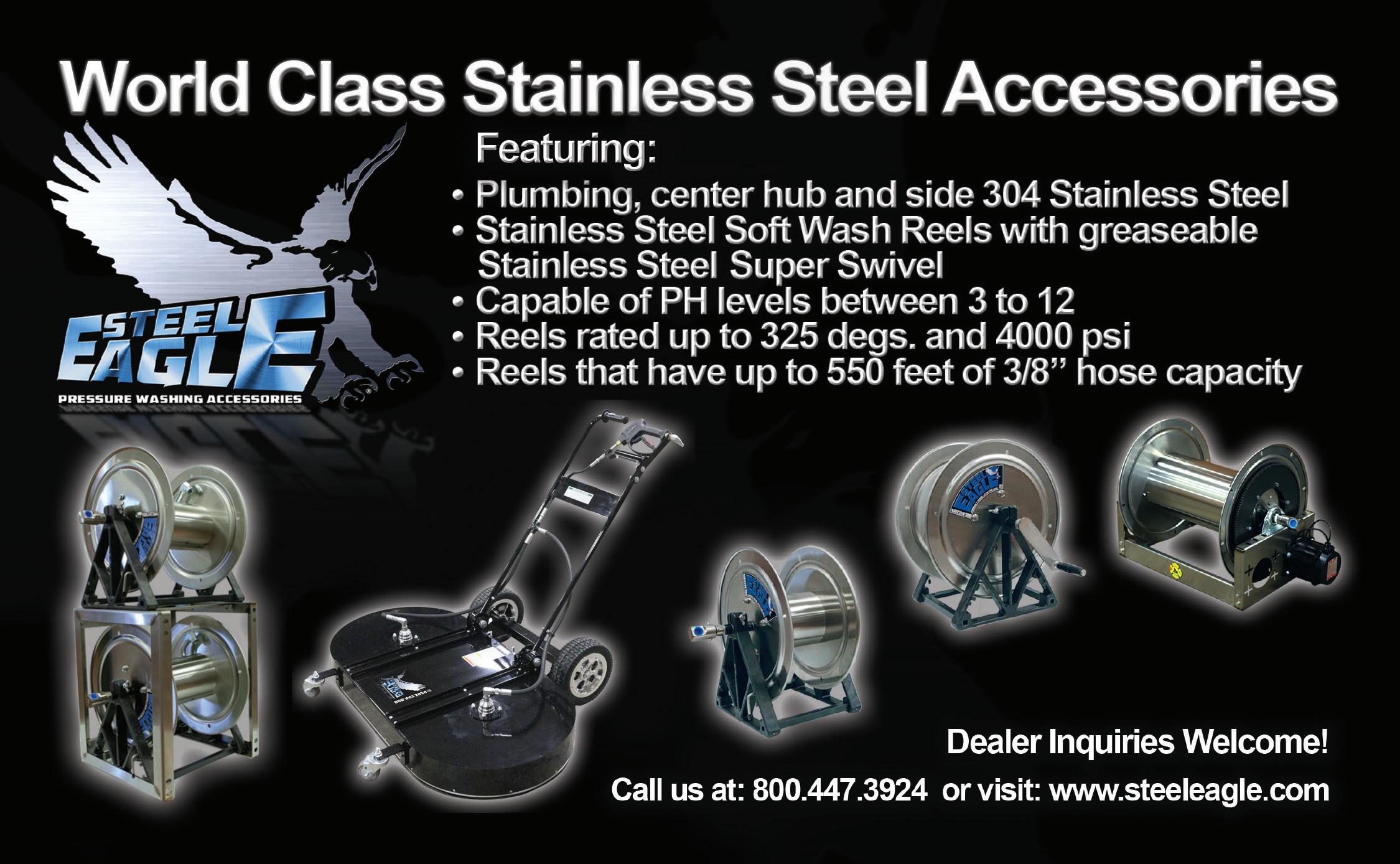
(soap injector, foamer, pump sprayer), detergents, and brush will get the job done. As the scale/scope of the business changes, higher gpm pressure washers, hot water capabilities, multiple machines, detergent switching equipment, water recovery systems, and increased water capacity becomes more crucial.
Cleaner Times: What should we have asked?
Reiffer: Due to the diverse nature of fleet vehicles, equipment styles, and environmental factors (temperature, weather, type of road film/debris), not all fleet washing processes are created equal nor will they perform identically for every wash every time.
Fleet washers must understand the impacts of cleaning variables and how they affect their washing. Factors such as water quality, temperature (water, air, and surface temps), cleaning pressure, dwell time, detergent strength, dilution rates, and vehicle conditions/ wash frequency will all vary and impact performance and efficiency.
Air And Water
A clean vehicle is a safer vehicle. Its windows provide maximum visibility. Lights project optimal illumination. And there’s no debris, caked-on dirt, or ice to add to weight or instability.
Truck washing will continue to be part of a good fleet management program. Water will be used, and the EPA will be assessing the procedures and results.
Yet in 2024 when the EPA refers to its “Clean Trucks Plan” (originated in 2021), the focus is on air pollution. Rules are multiplying quickly, and the goal goes well beyond what we now know are the interim benchmarks reducing emissions that contribute to smog and soot. The goal is to achieve greater application of zero-emission vehicles.
The money the federal government is putting into projects that move toward electric vehicles is enormous. Our readers know the progress of the zero-emission goals in California. The goals in the Golden State are the template for the nation.
In April 2024 the Federal Highway Administration (FHWA) announced that almost $150 million of $400 million expected had been awarded to enable certain states to replace gas- and dieselpowered vehicles used near America’s ports. The replacements are to be EVs.
Niche funding—grants—programs of many sorts are being carved from money in the Inflation Reduction Act (IRA) of 2022. Much of the funding relates to projects that reduce emissions of gases into the atmosphere. And EVs are receiving a great push with some of the roughly one trillion dollars in the package. Most of the allocations from the IRA will be made in support of climate initiatives, including the explicit one of reducing carbon emissions by 40 percent by 2030. The ongoing and gradual shift toward EVs will reduce much of the soiling that must be countered with washing. And it will certainly reduce the amount of waste from gasoline and diesel that must be factored into wastewater handling. But fleets will still have to be washed. CT
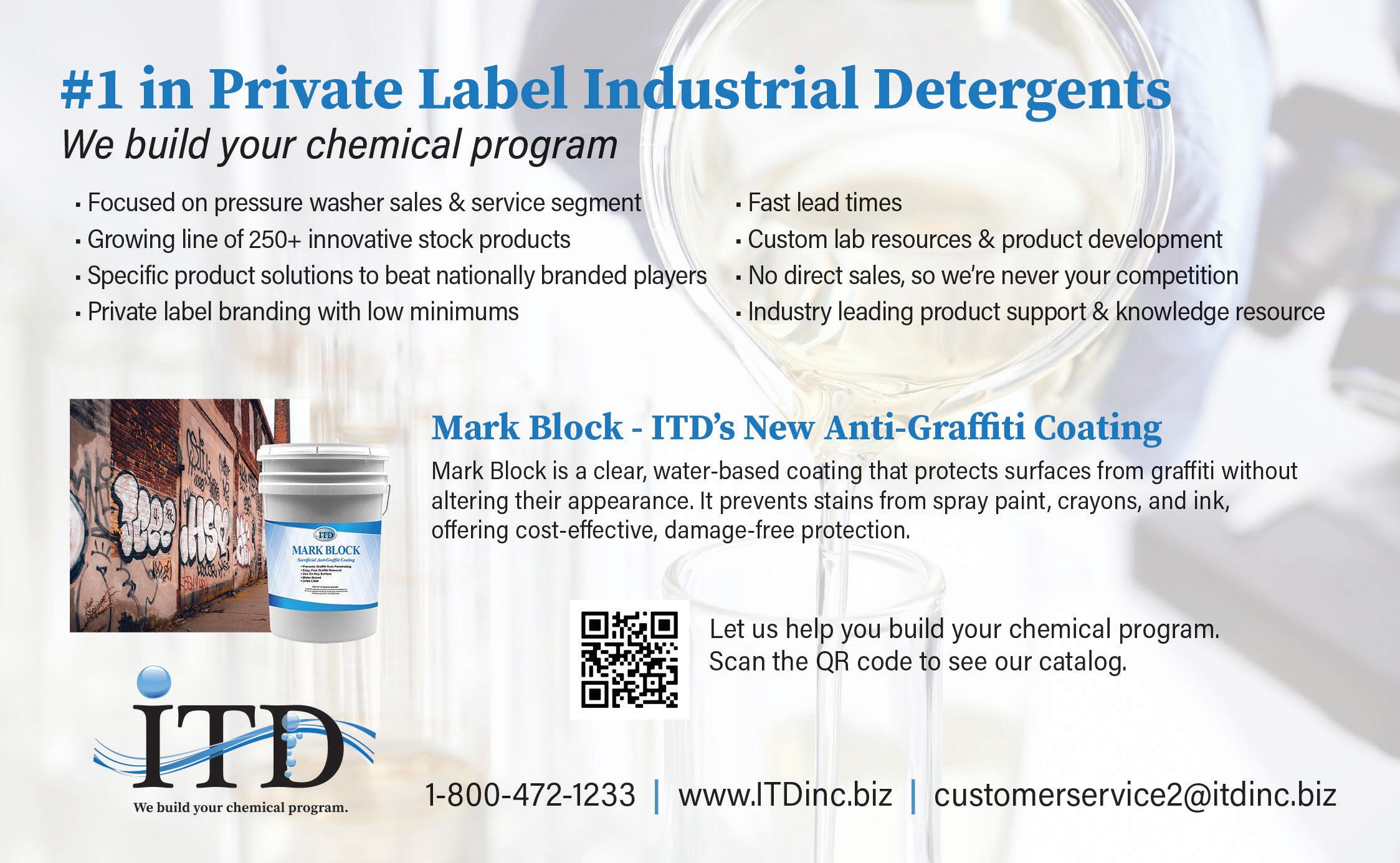

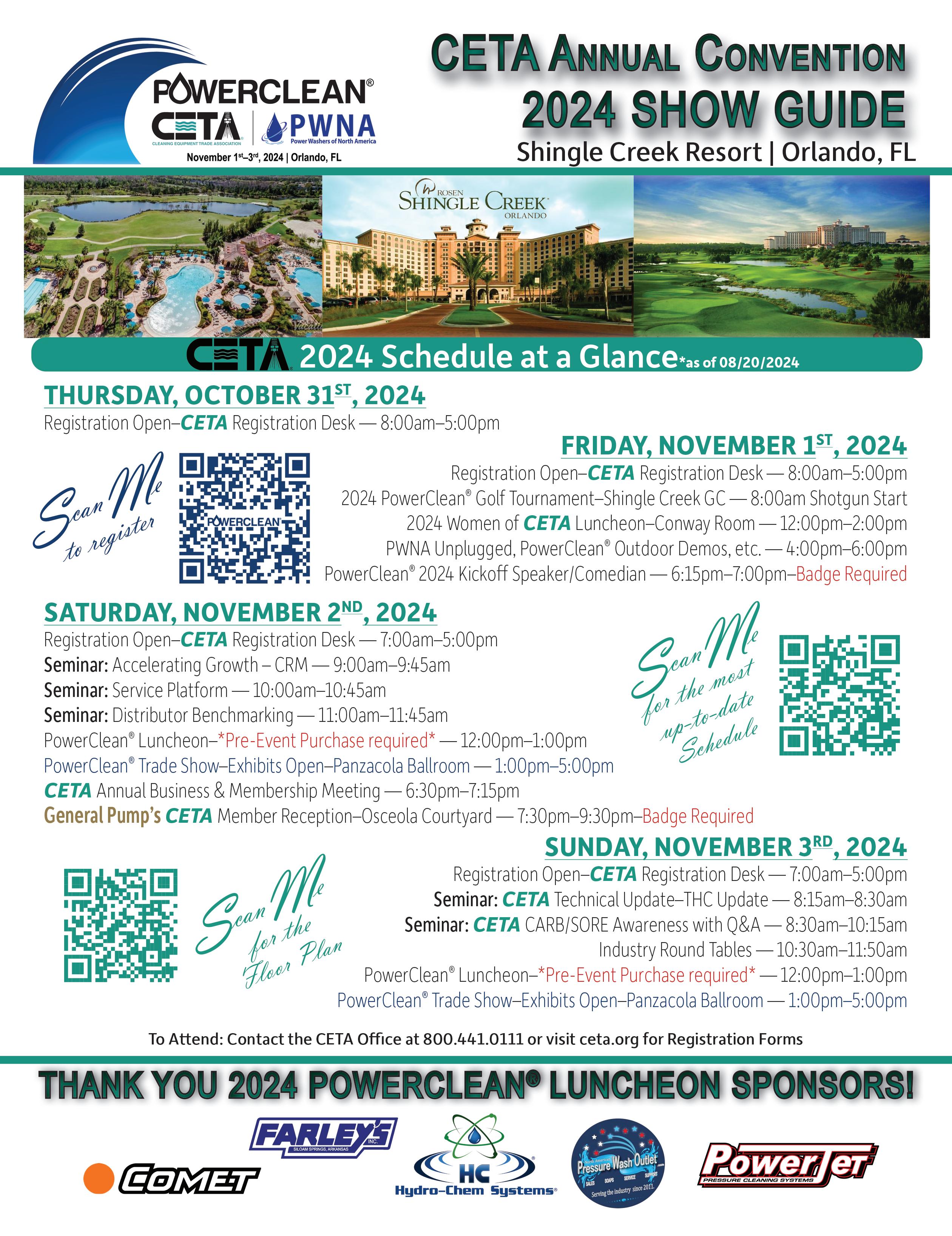
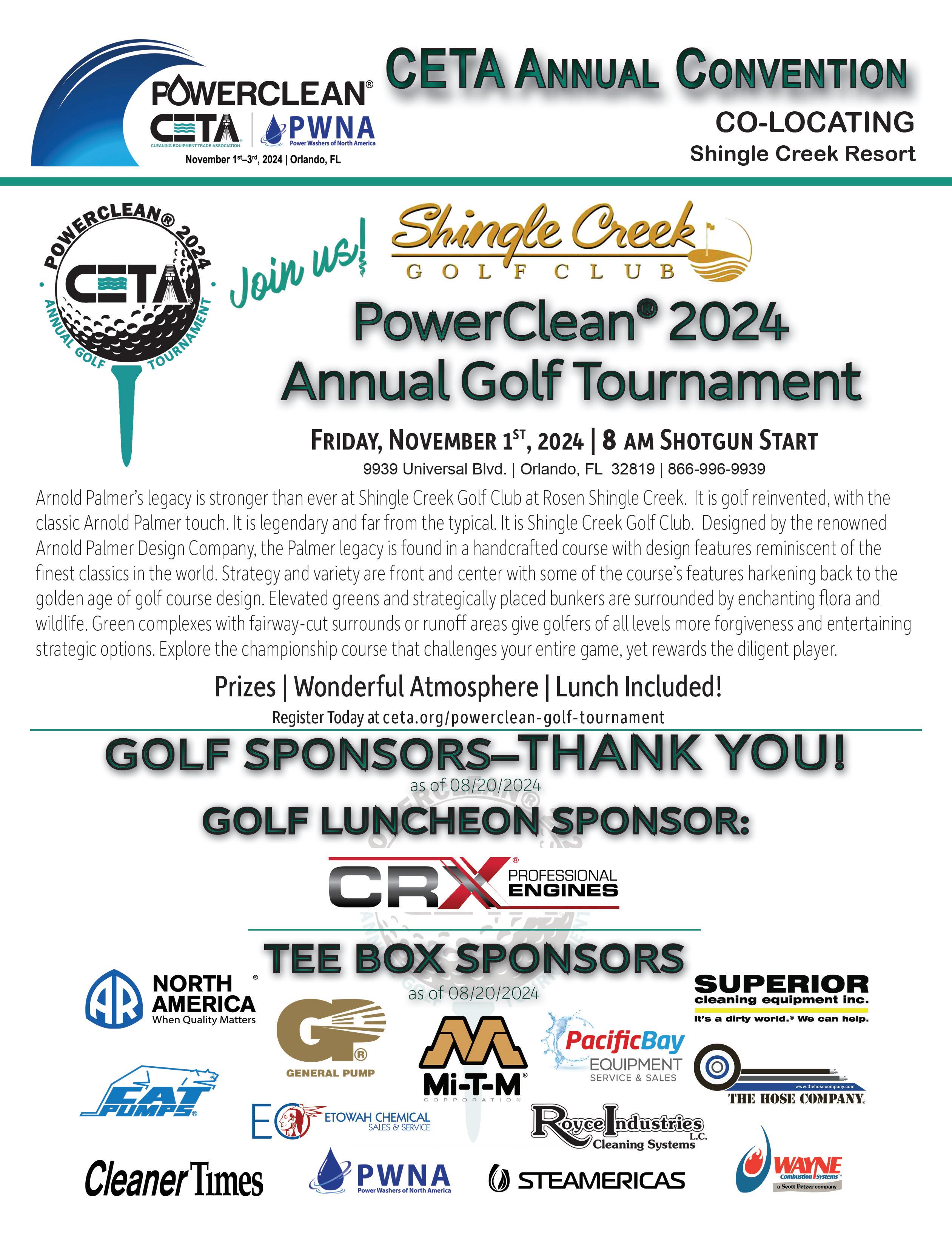
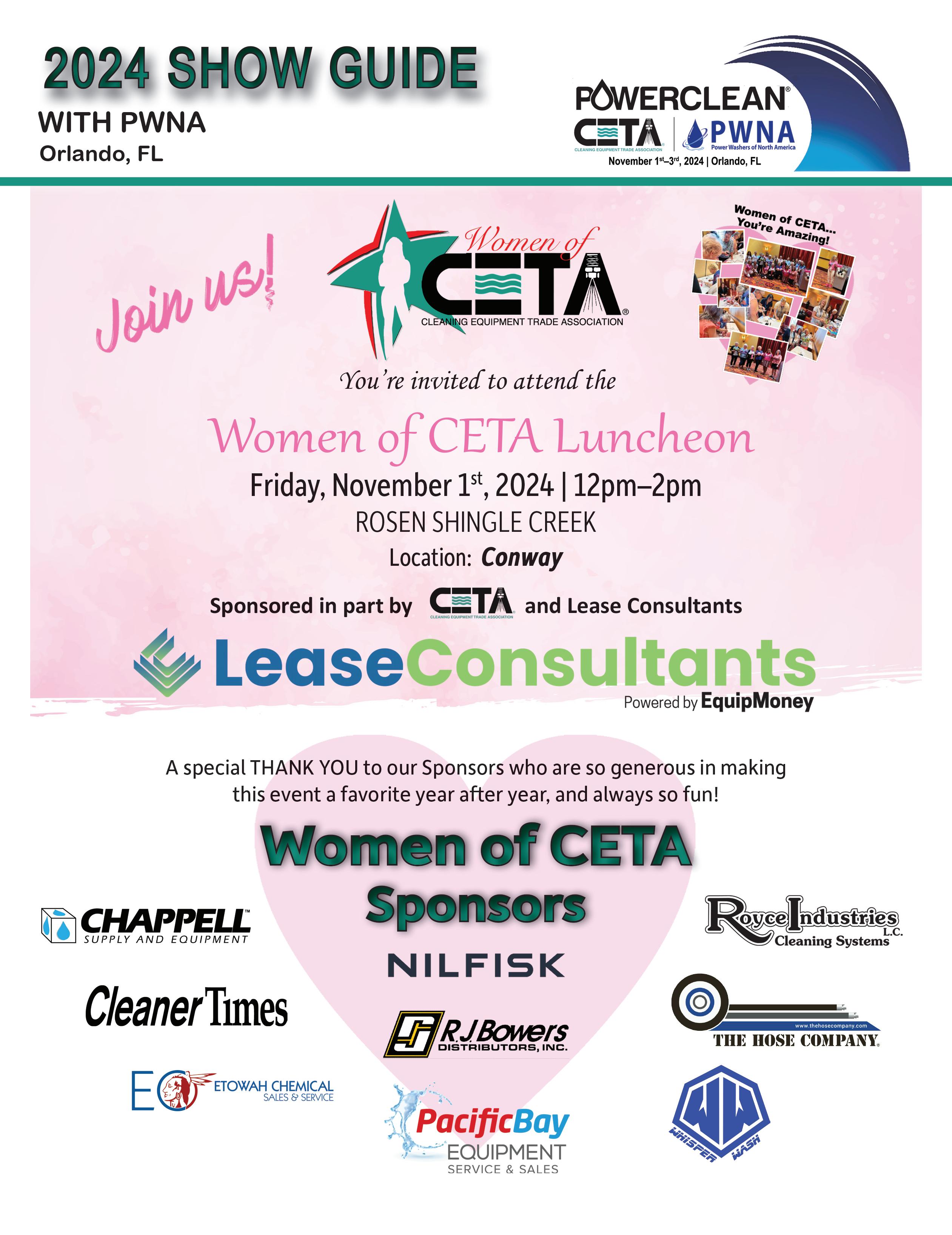
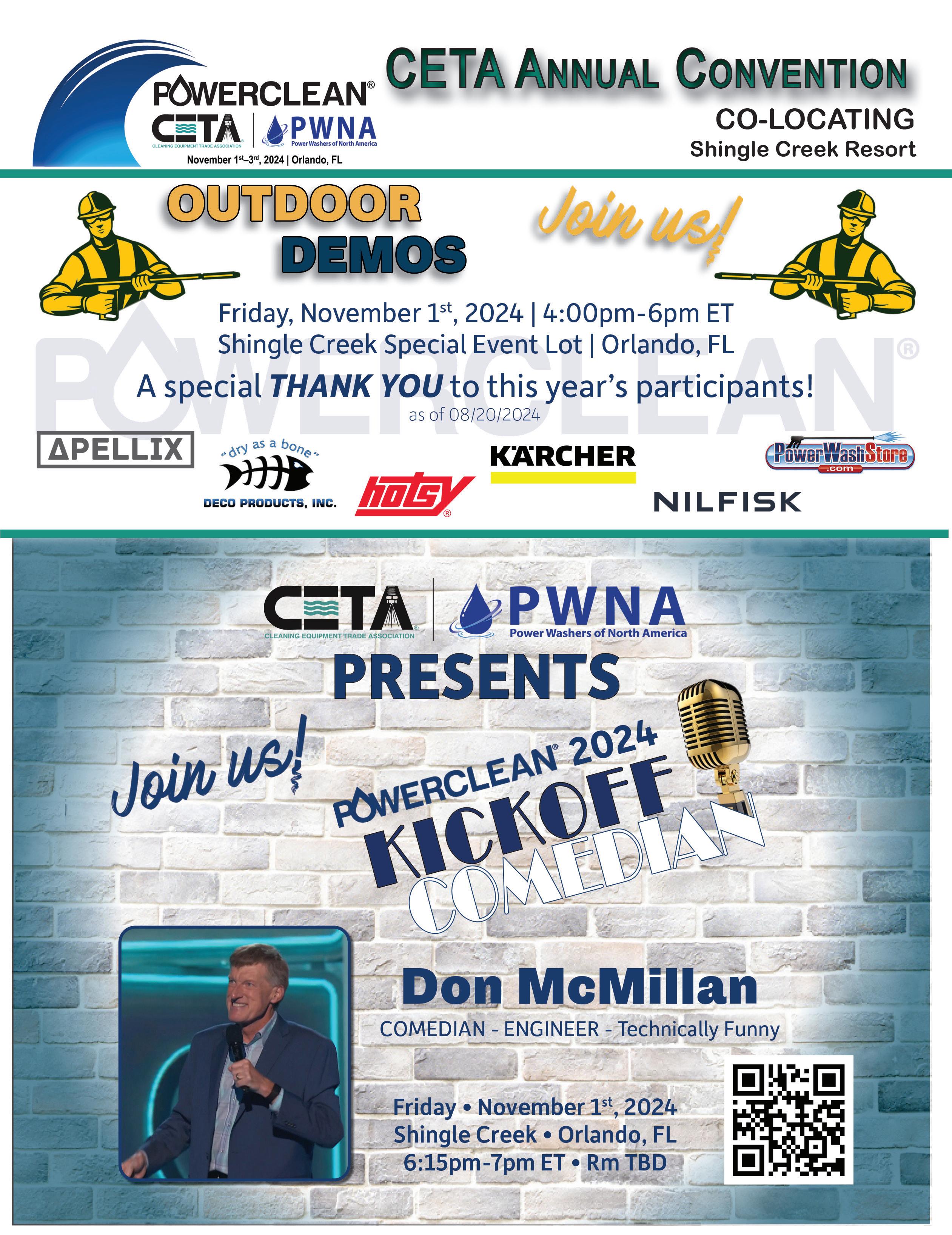
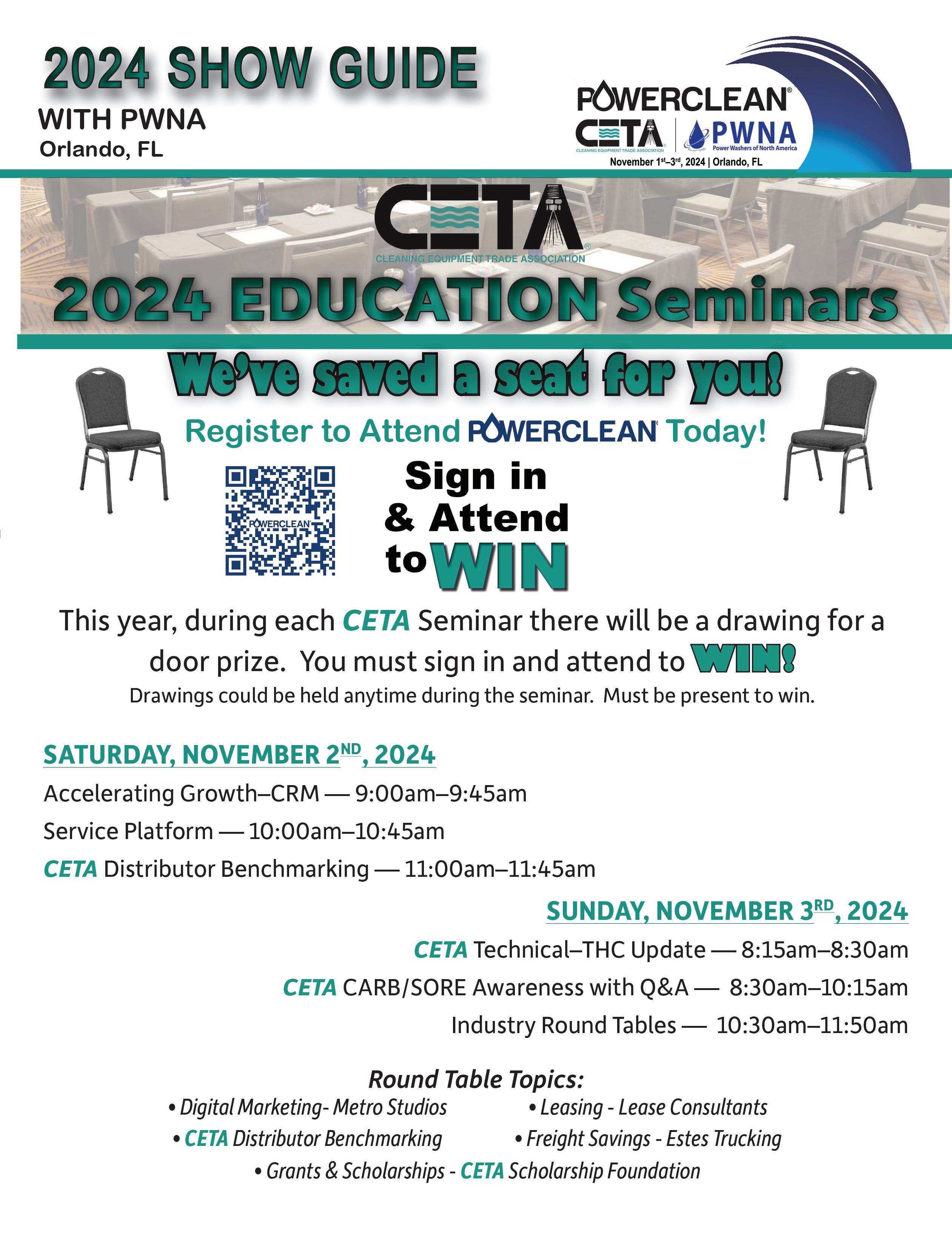
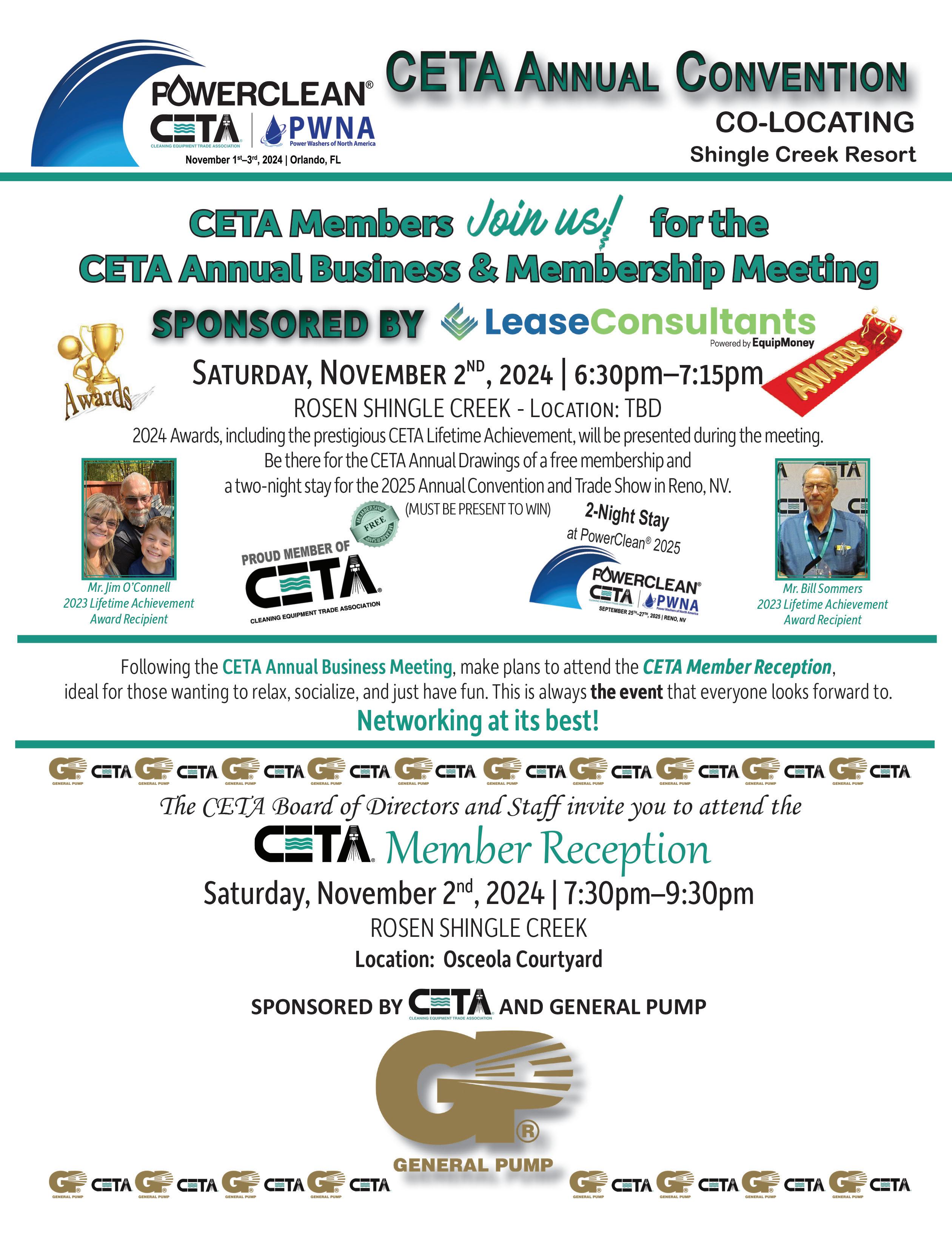
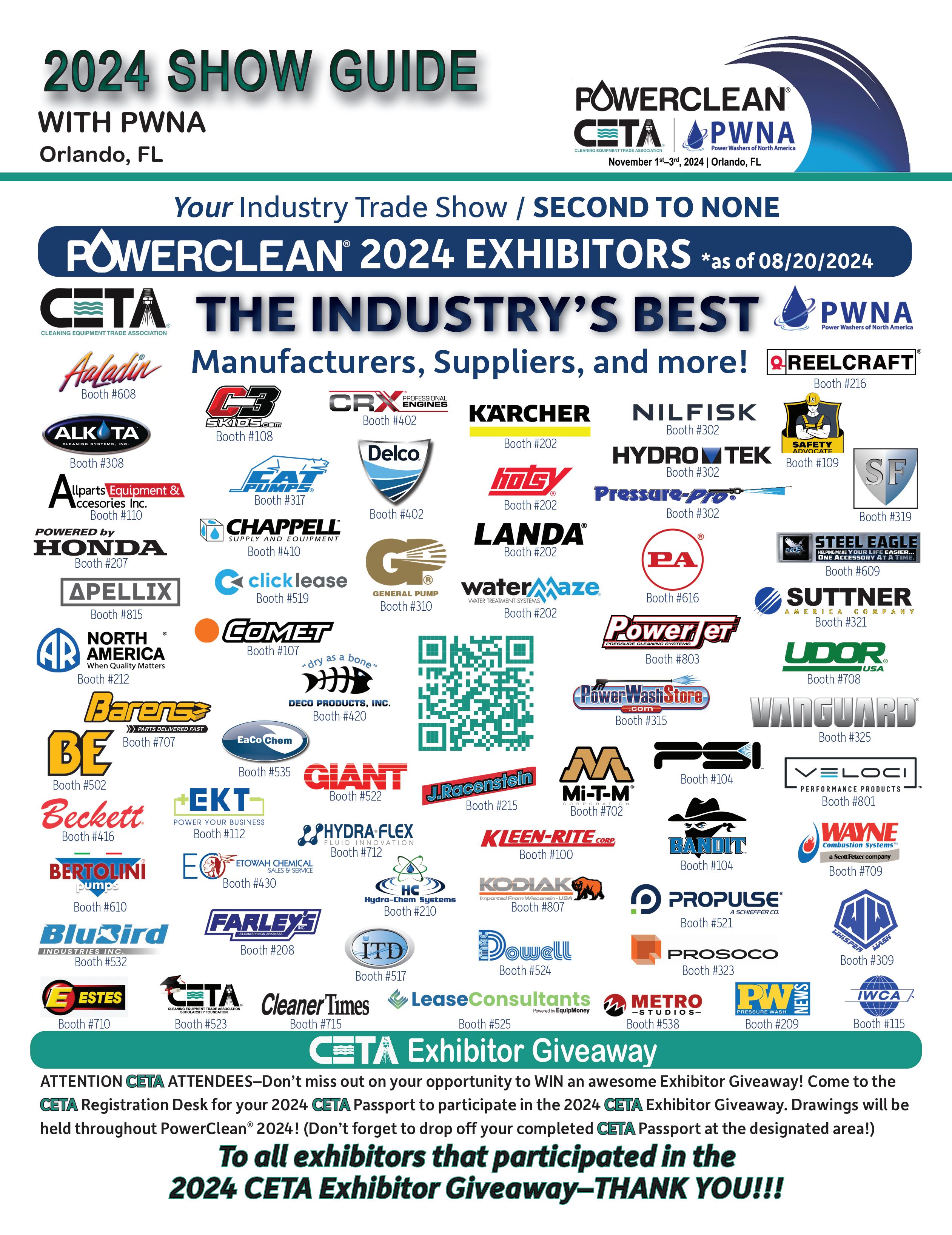
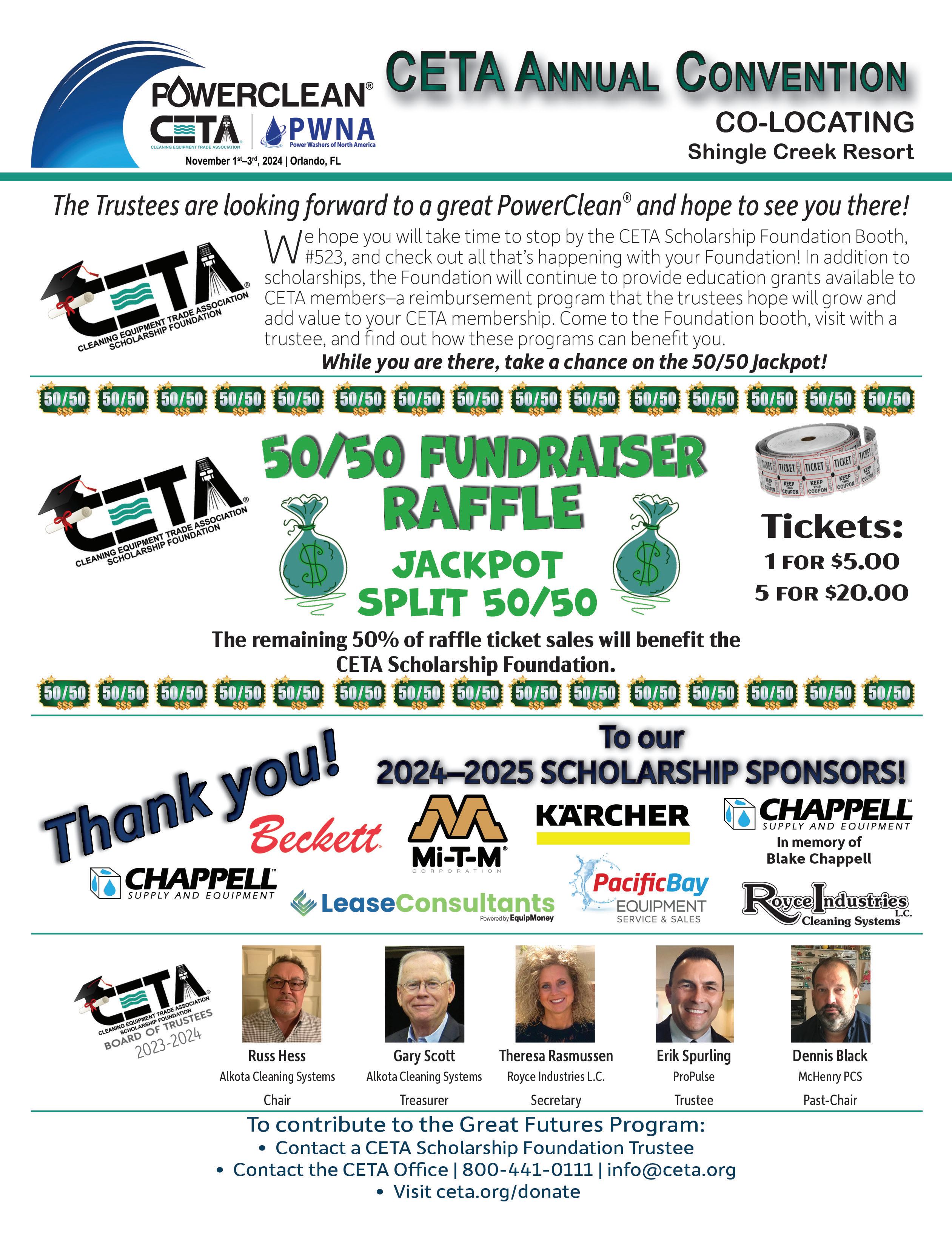
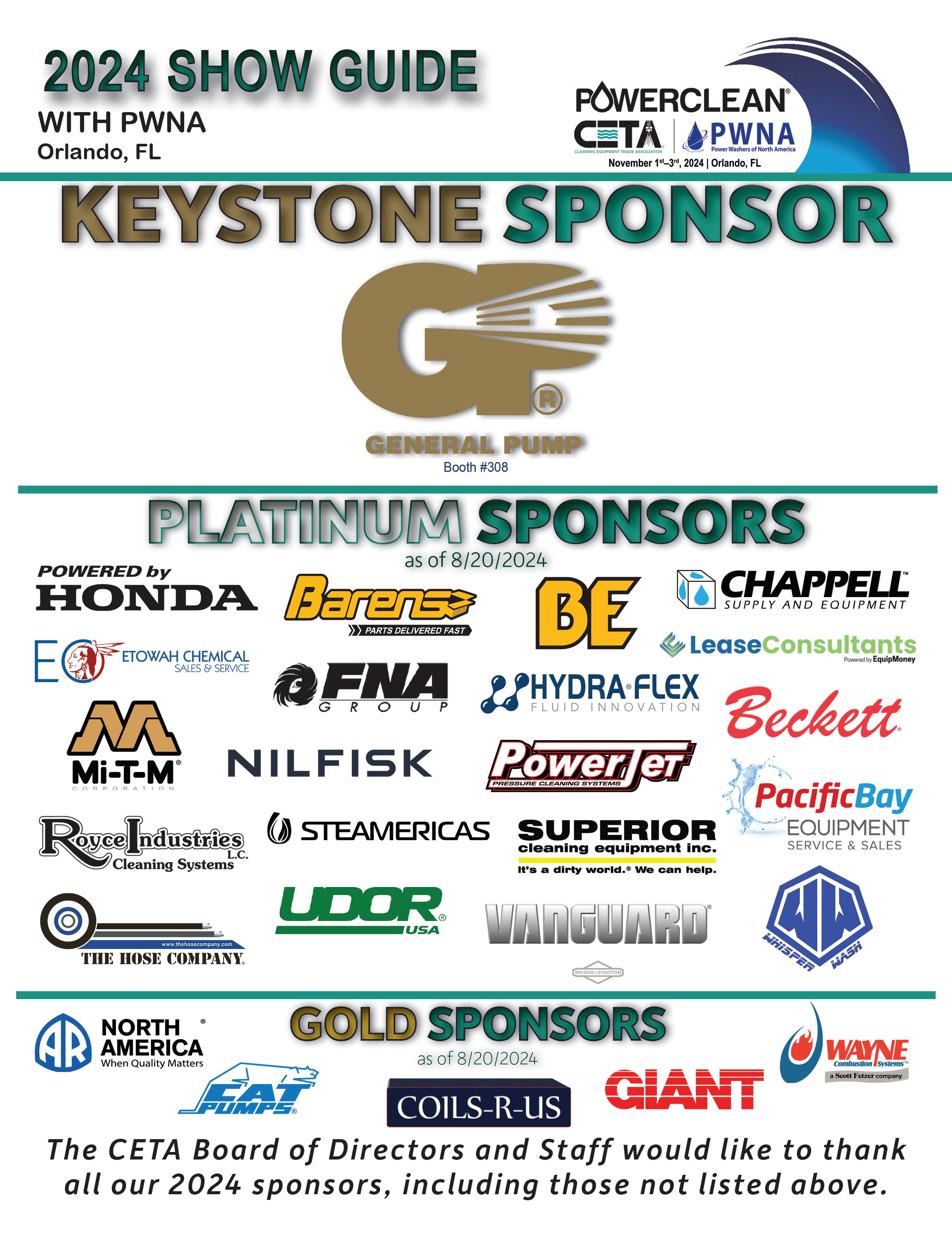
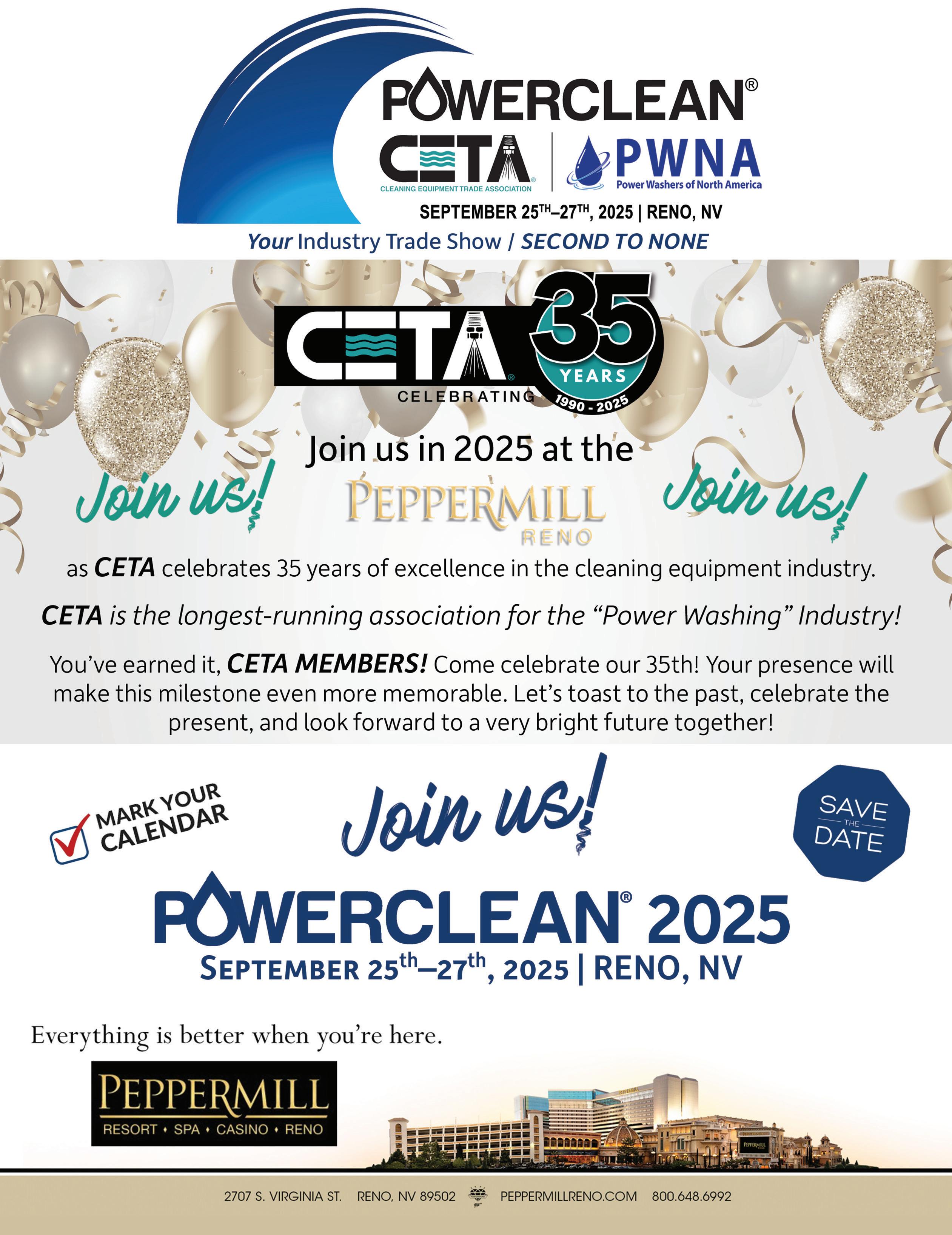
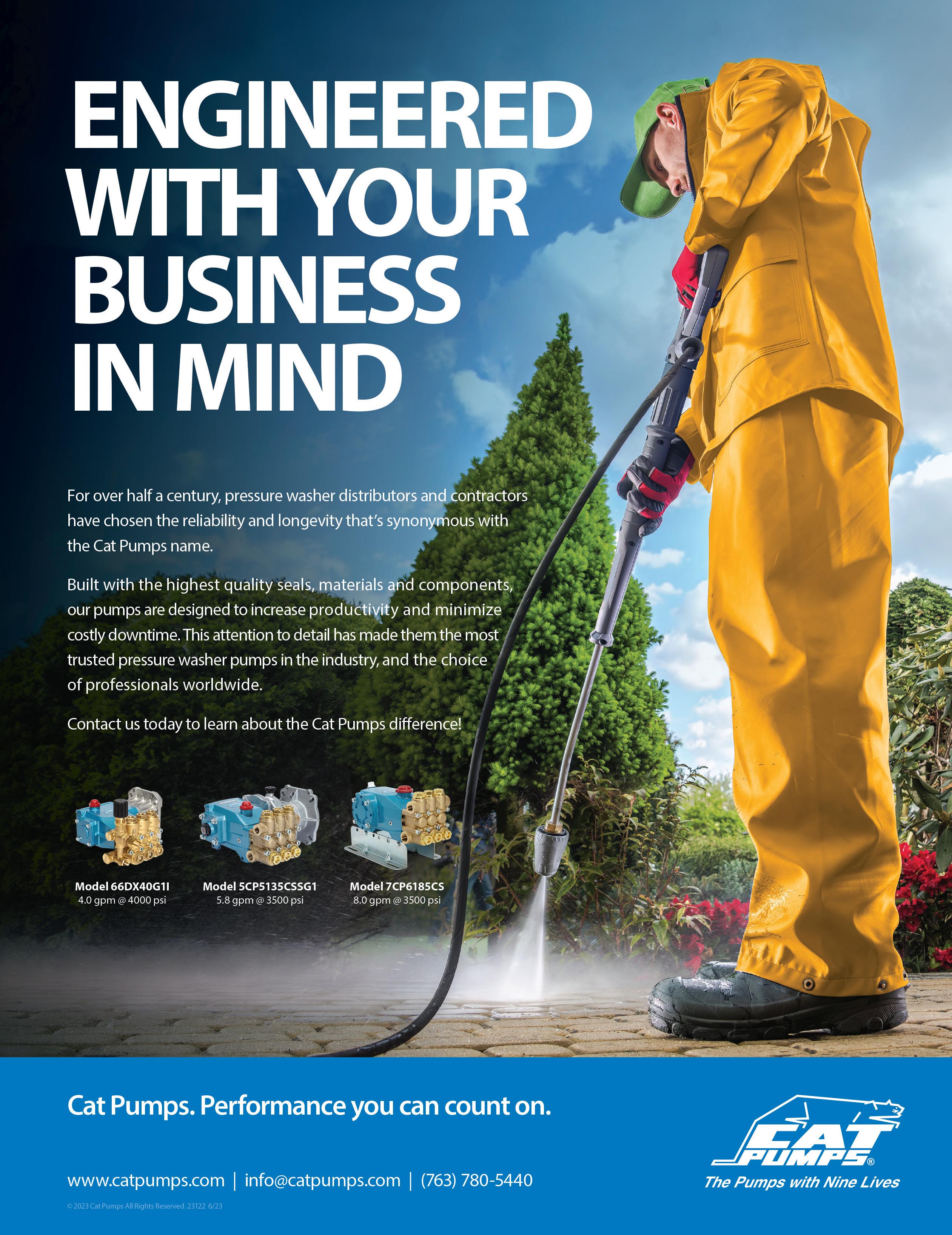

Looking for certain growth?
Bet on regulations.
Complying with regulations is a challenge certain to become even more difficult. From emissions to employment rules, meeting the expectations set by regulators at all levels of government consumes time and money. Regulations can be ambiguous. They can also be contradictory. Responses to questions at sites such as OSHA [Occupational Safety and Health Administration] often miss the mark on clarification.
Then there is the sheer number of regulations. A good place to get a sense of how many regulations there are—and how many are coming—is Regulations.gov . The website allows a user to review pending regulations, read them, and make comments during comment periods. The website also enables users to search for existing regulations that apply to a business.
Knowing federal regulations is not the same as knowing all the regulations that apply to a company. State and local governments also put requirements on businesses. They stipulate many licensing and employee work rules. They also impose rules on environmental and safety issues.
Rules are so numerous that an in-house compliance officer is now as important as an in-house certified public accountant. Even if compliance is only part of a team member’s job, an in-house point person on regulations helps avoid running afoul of rules.
Where to begin? Dan Pearson, senior regulatory affairs manager at Kärcher North America Inc. in Aurora, CO, recommends keeping pace with rules via the easily available tools. “Sign up for the automatic email updates provided by the agency making and/or enforcing the rules,” he says.
That can mean alerts coming from several different agencies. And again, it emphasizes the need for a team member focused at least part-time on regulations.
Talk with any member of our industry who spends a great deal of time immersed in regulations (e.g., company leaders, dedicated compliance officers, and safety advocates), and each will offer some concerns about rules that do not seem to be sufficiently understood. Their concerns, when summed up, illustrate the complexity of compliance.
Pearson says that from his vantage three regulatory issues vexing members of the industry currently are PFAS, CARB regulations, and efficiency standards. What unites the three is that the rules for each are still to be firmed (i.e., are in flux).
PFAS [Perfluoroalkyl and polyfluoroalkyl substances] include thousands of chemicals used in industrial processes. The Food and Drug
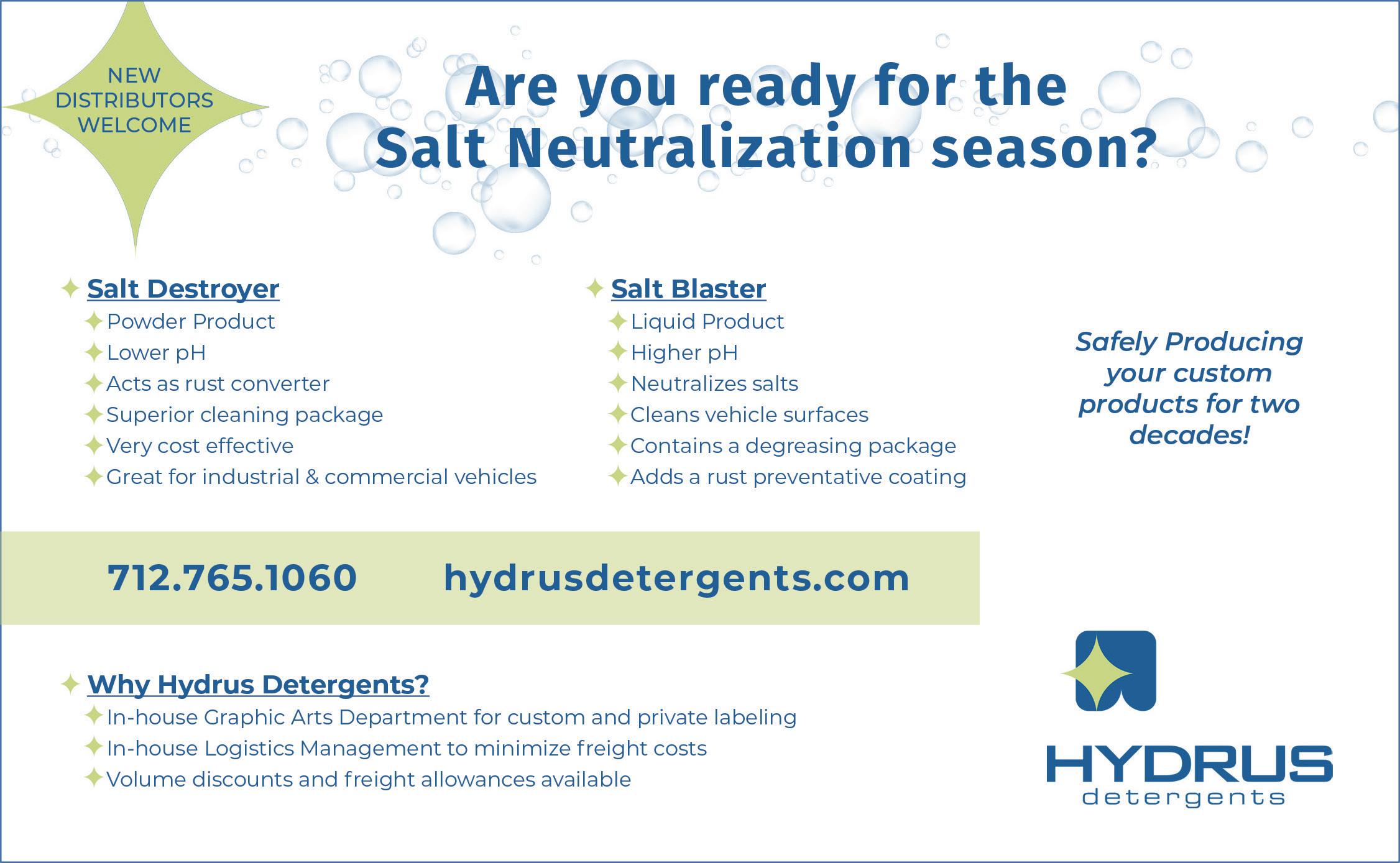
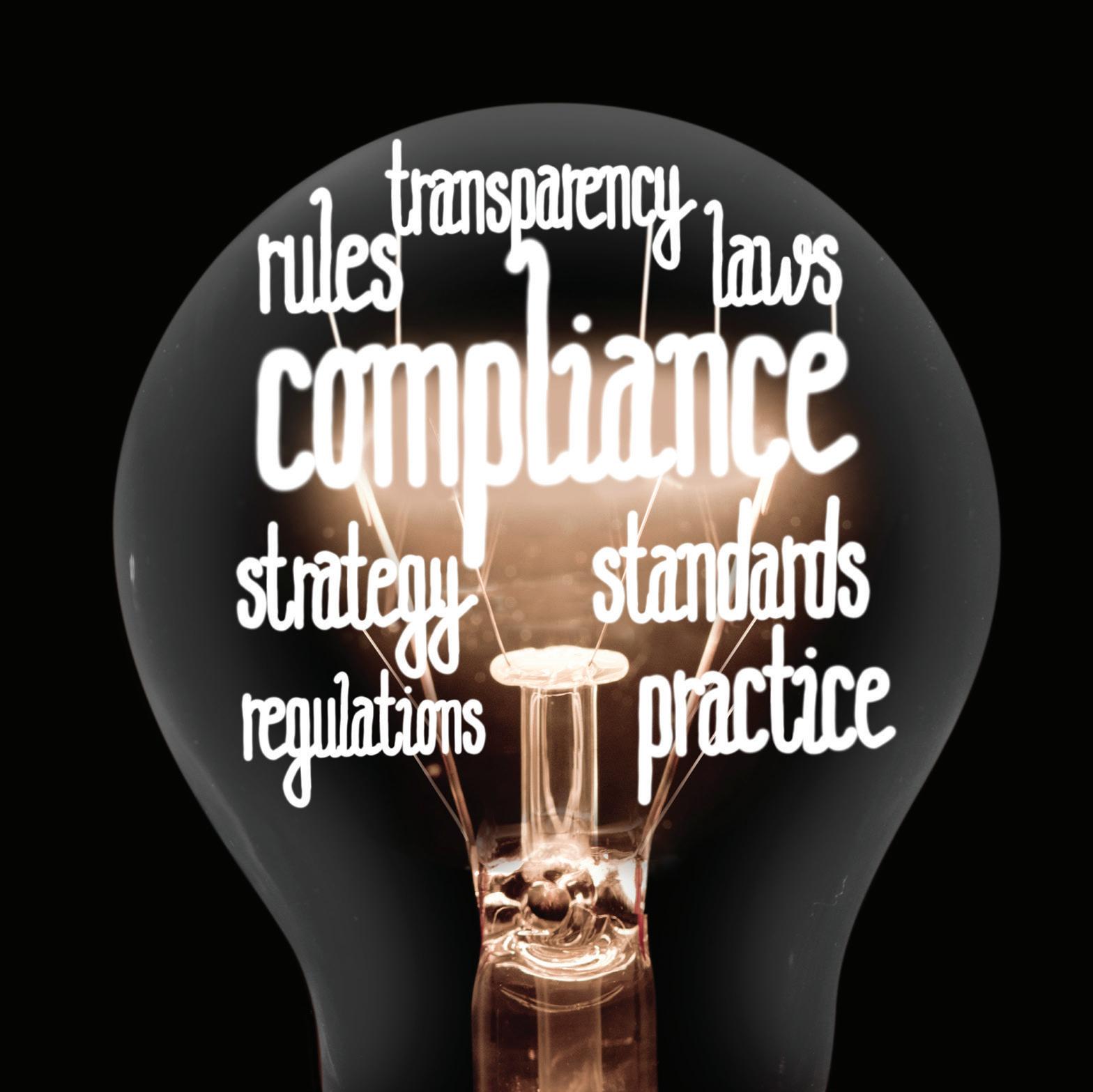
Administration ( FDA.gov ) takes a great interest in them and is monitoring them by region because they are found in the tissue of living organisms and may be linked to diseases.
CARB is the California Air Resources Board, which has established the most stringent emissions goals in the nation. The goals have been adopted by other states.
Efficiency standards are linked indirectly to emissions, but there is a primary thrust regarding standards— to reduce energy consumption.
Chemicals
Every sector of the economy uses chemicals and produces chemical byproducts. Moving and storing chemicals safely is a major concern for our industry.
Linda Chambers, the brand and sales manager at GCE/Soap Warehouse Brand in Norcross, Georgia, has a particular concern about the storage and transport of sodium hypochlorite. It’s a concern, she says, that is reignited almost every day.
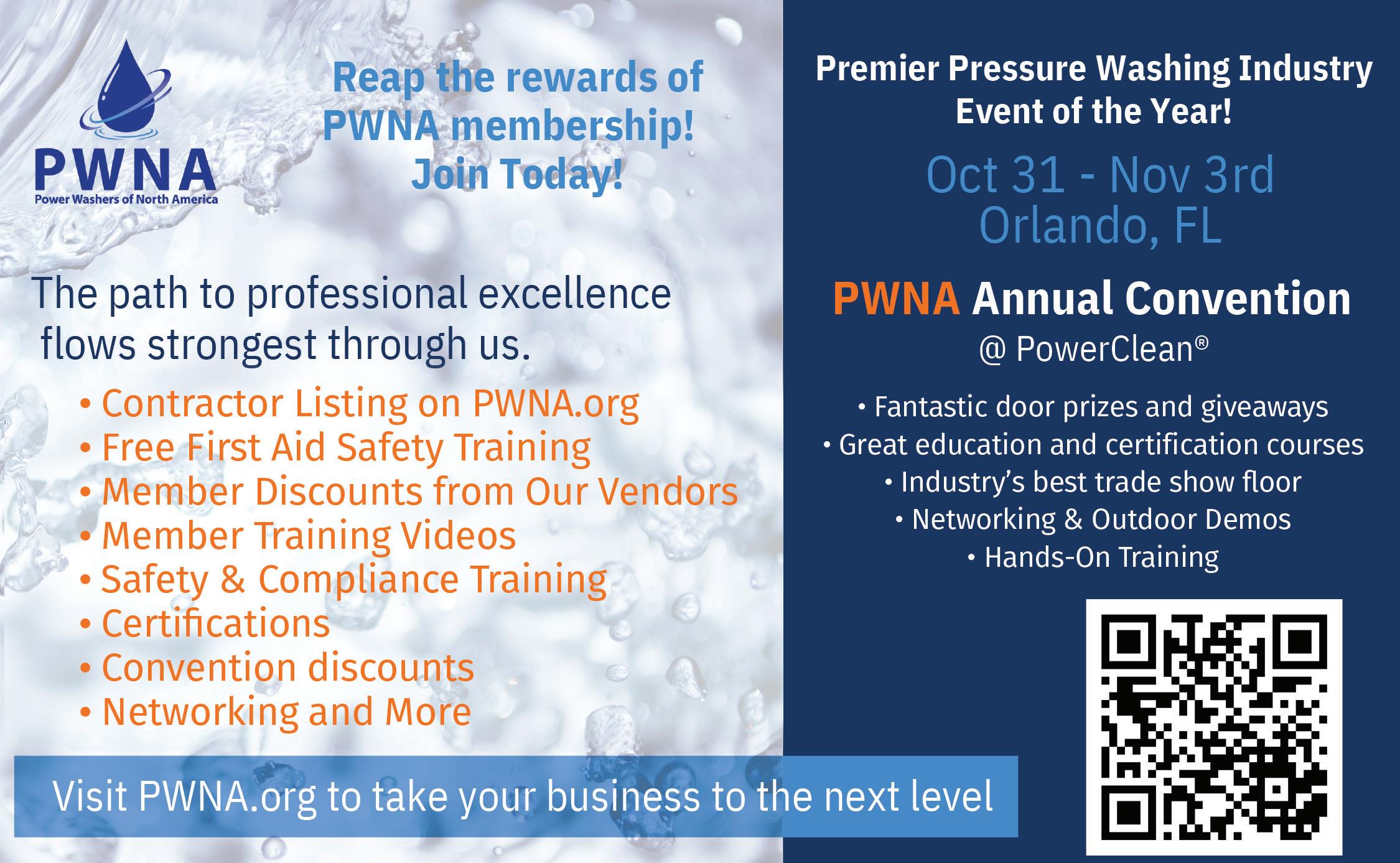
“Not following DOT [Department of Transportation] regulations for transporting bleach, sodium hypochlorite, which is a hazmat number 8 corrosive, is a serious matter,” explains Chambers. “Too many vendors are building and selling chemical storage tanks, which are made to sit stationary on the ground, to be used on trailers and vehicle builds that are not UN-certified, hazmat transportation containers.”
In other words, a container built for one purpose (stationary storage) cannot simply be deployed as a transit container. The concern that Chambers expresses is one we have heard from others in the industry. [See the sidebar on sodium hypochlorite for a bit more on the topic of transport safety.]
Chambers says that her company has a strict policy regarding sodium hypochlorite. “Our company cannot and will not fill those poly tanks [not built for transport] with bleach.” It will only fill UN-certified tanks.
There are many companies that do fill the inappropriate tanks. “Eventually, if DOT catches them, they will be fined,” says Chambers.
The fine, however, does not redress the hazard of chemical in the wrong tank traveling down a roadway. We can imagine worst-case scenarios.
Another big concern for Chambers is the lack of compliance among some contractors. “Small contractors not complying with OSHA regulations is also a serious matter,” she explains. That includes “everything from not training employees to not attending to little things like getting SDS [safety data sheets] for the chemicals they use and making SDS binders.”
It takes time and focused effort to stay compliant. There are no shortcuts. It is possible, but quite expensive, to hire outside compliance help— particularly expensive for small contractors. In lieu of that, Chambers has some recommendations.
“You can get online to find and learn the regulations for your business and your location,” says Chambers.
“Most can be found for free by going to the DOT and OSHA websites.”
There are also many options in paying for assistance. “There are plenty of companies out there that will sell contractors information in multiple ways—print, videos, and online programs,” says Chambers. “The problem is if you want it fast and easy, then you have to pay for the work someone else has done to spoon feed you information.”
Chambers’ company strives to help. “We pass along as much information as we can for free,” she explains. “I even give a class on how a small contractor can develop and use a training program that can fulfill OSHA requirements.”
With the how-to in hand, says Chambers, the contractor has the outline needed to tailor a program to his or her company. But she reminds us that there is still work involved.
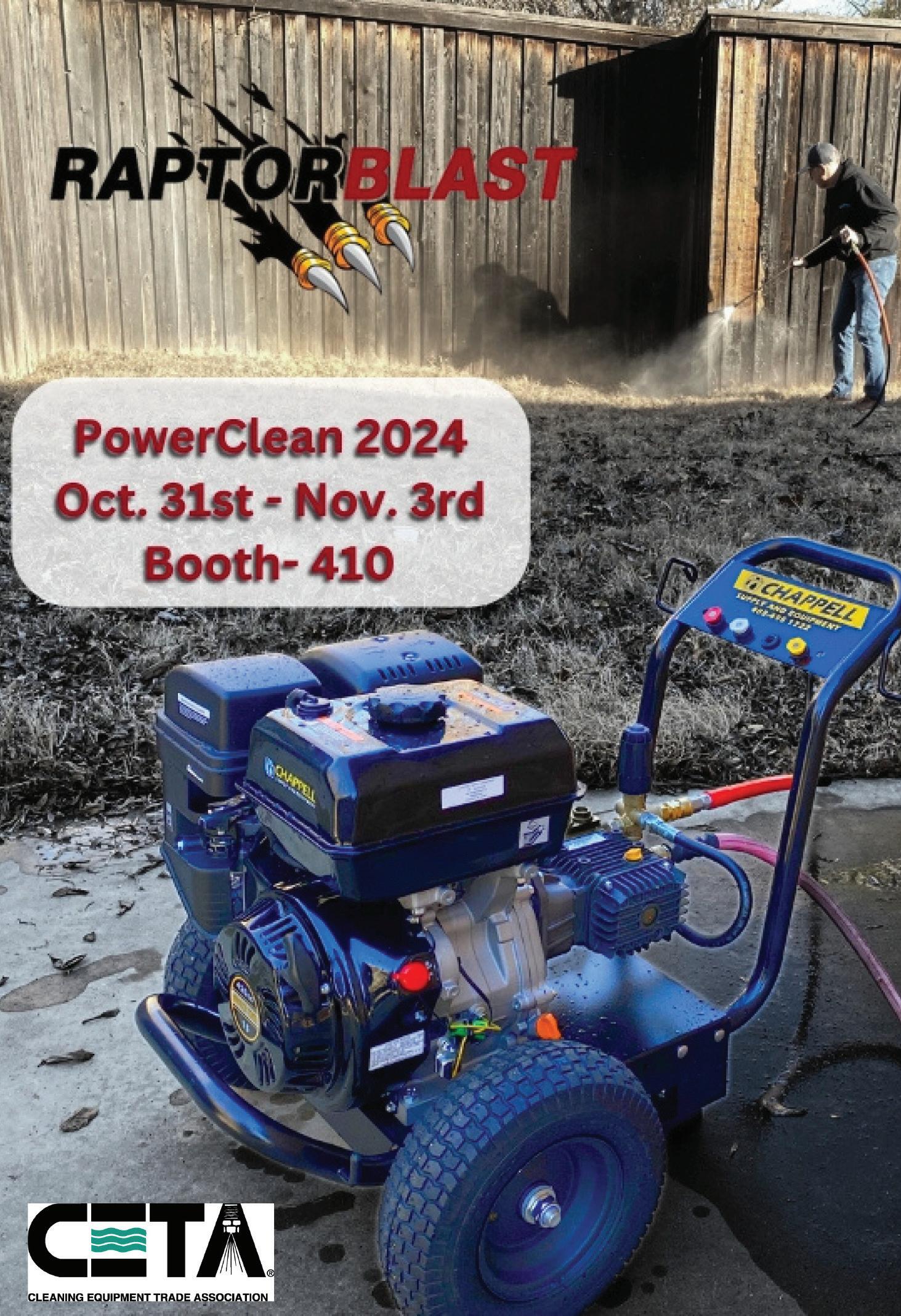
Corrosives belong to UN class 8 of chemicals. Thus, sodium hypochlorite belongs to UN class 8. By definition, a corrosive substance can react with an organic or metal material on contact. The contact can cause a reaction that results in deterioration of the organic (e.g., a tissue such as skin) or the metal.
Containers holding chemicals belonging to UN class 8 must be labeled with a placard (pictogram and number) that indicates they contain a corrosive. (Similarly, containers of explosives—class 1, gases— class 2, and flammable liquids—class 3, and so on must be labeled with appropriate and corresponding UN class placards.)
Sodium hypochlorite transport must only be done in a container that is designed to hold the corrosive compound. The container must be suitable for—constructed for—its use. That means a container that is used on a vehicle, such as a tank on a trailer, must be built to travel on the road. A container/tank sanctioned for on-road use will have more integrity and be less vulnerable to rupture or spills than one used only as a stationary container. (A road-worthy container could, of course, be used as a stationary container.)
Being readily soluble in water and having strong oxidizing properties, sodium hypochlorite is valuable for cleaning when in solution. Bleach is a dilute solution of sodium hypochlorite.
FMCSA, which is cited in the main text of the article, is not the only DOT entity that oversees safety. Motor carriers that transport certain classes of hazardous materials or hazardous materials with high weights (“high weight” defined by the specific chemical) of certain classes of hazardous chemicals must register with PHMSA [Pipeline and Hazardous Materials Safety Administration].
Contractors buying tanks to transport sodium hypochlorite solution should ask the vendor to verify that the tank is suitable for mobile use—that is, meets the requirement to be fitted with a UN Class 8 placard and used with maximum safety on the highway. If it is not, it should not be used for transport. That’s the bottom line.
An excellent primer entitled “Transporting Hazardous Materials by Highway—New Carrier Information Guide” is available from the DOT. See https://www.fmcsa. dot.gov/sites/fmcsa.dot.gov/files/2021-11/Haz Mat%20General%20Information_FINAL_508c.pdf.

ENGINES, ENVIRONMENT, AND MORE
There is probably not a member of our industry who has not heard about the SORE [small offroad engine] rules that originated with CARB. Yet there are many members of our industry who still do not understand the implications of SORE.
“Currently understanding the regulations like California’s SORE requirements and the upcoming changes in Washington and Oregon” is difficult for industry members, says Christopher Blann, CEO of Powerwash.com in Fort Worth, TX. One reason for the difficulty is that the regulations continue to be refined even as the reach expands.
“Many do not fully understand the federal and state EPA [Environmental Protection Agency] wastewater requirements or fully understand the local municipalities’ rules and regulations,” says Blann. “We teach many classes at our company and its eponymous academy covering these topics; but every municipality has different rules and regulations, so everyone is responsible for doing that research and then complying with the rules and regulations.”
Blann appraises the landscape of regulations. “It can be crazy out there,” he says.
How can one hope to navigate the complex terrain? “The advice we give is to first understand the federal and state requirements as that has to be done if there are no local rules, and apply them in conjunction with local requirements,” says Blann. “Second, go to your local city hall or code enforcement office and learn directly from those local leaders what is required.”
Commitment is necessary. There are no shortcuts.
“It’s better to be proactive than take risks as fixing the situation can be very expensive and even land criminal charges,” says Blann. “It is not worth the risk.”
Blann offers advice specific to contractors: “Is asking your buddy or other pressure washers or searching YouTube for the local and federal requirements a good idea? No, you have to do the research.”
A recurring question surfaces for anyone who’s trying to sort through layers of requirements, says Blann. “What is the hierarchy for the rules and regulations? That is easy. You have to comply with the most stringent rules for the area. For example, if a city says you don’t have to recover water but the state says the opposite, then you follow the state’s rules.”
Rules Of The Road
The breadth and depth of regulations can amaze even industry veterans when they stop to reflect on the scope. “As president of the Cleaning Equipment Trade Association, CETA, I’ve observed one of the most challenging issues for industry members is keeping up with evolving environmental regulations,” says R. Calvin Rasmussen, CEO of Royce Industries L.C. headquartered in West Jordan, UT.

“Staying compliant with environmental rules encompasses understanding and adhering to standards for chemical and detergent usage, transportation, disposal, and more,” explains Rasmussen. “These regulations are frequently updated and can differ significantly across regions, making it tough for companies to stay informed and compliant. Moreover, the push for sustainable practices adds another layer of complexity to an already intricate regulatory landscape.”
Taking in the broad view of our industry, Rasmussen says that he would focus on the DOT regulations concerning handling of transportation of chemicals and detergents if he were to “highlight the most common regulatory hurdle”—meeting regulations that aim to ensure safety, efficiency, and reliability in transportation.
Rasmussen explains the components of DOT rules are in place for good reasons. “They are designed to promote safety, prevent road accidents, and protect first responders and citizens in the event of spills or exposure. These regulations are enforced by various DOT agencies, such as the Federal Motor Carier Safety Administration (FMCSA.)”
Among the regulations from DOT and its sub-entities that require attention, there are seven Rasmussen advises no one overlook. They are the requirements for CDL [commercial driver’s license] holders, hours of service (HOS), vehicle maintenance and safety standards, hazardous materials (hazmat), drug and alcohol testing, weight and size limits, and electronic logging devices [ELDs].
ELDs? “Commercial drivers are required to use ELDs to record driving hours and ensure compliance with HOS rules,” explains Rasmussen.
Add the regulations Rasmussen cites to those that Pearson, Chambers, and Blann cite, and the list is long. But it is still only a partial list. Employment law, for instance, cannot be forgotten. The CDC is right in there with OSHA making rules for worker safety.
“While there may not be a straightforward way to simplify or streamline compliance efforts, I strongly recommend that my fellow CETA members leverage resources available to them,” says Rasmussen. He adds that attending the association’s annual meeting, PowerClean, and regional meetings as well as visiting its website makes keeping up with regulations easier.
Members of PWNA and UAMCC can take an analogous approach. Tap all the information a professional organization has to give. CT
